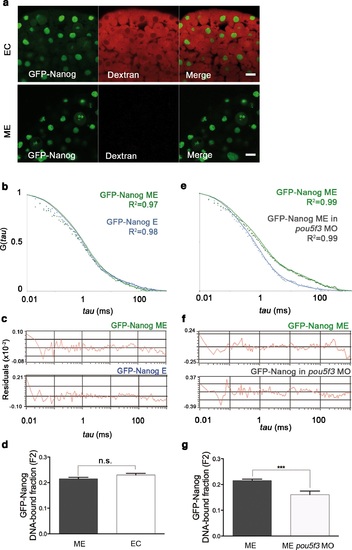Fig. 2 S3
- ID
- ZDB-FIG-161103-21
- Publication
- Perez-Camps et al., 2016 - Quantitative imaging reveals real-time Pou5f3-Nanog complexes driving dorsoventral mesendoderm patterning in zebrafish
- Other Figures
- All Figure Page
- Back to All Figure Page
|
GFP-Nanog dynamics in blastula embryos. (a) Cells from the blastoderm (oblong stage; 3.5 hpf) expressing GFP-Nanog. Ectoderm (EC) cells are positive for dextran red; mesendoderm (ME) cells are negative. Scale bar: 20 µm. (b) ACF of the intensity traces of GFP-Nanog in EC and ME in wild-type embryos. The ACF were fit by two-component anomalous diffusion model. Curves are normalized to compare differences in protein activity. (c) Raw data of residuals from fit curves shown in b. (d) DNA-bound fraction derived from the previous ACFs. Values represent the mean ± SEM of data from three to five independent experiments (n > 60 cell nuclei from 10 to 15 embryos; ****p<0.0001). (e) ACF of the intensity traces of GFP-Nanog in EC and ME in pou5f3 morphant embryos. The ACF were fit by two-component anomalous diffusion model. Curves are normalized to compare differences in protein activity. (f) Raw data of residuals from fit curves shown in e. (g) DNA-bound fraction derived from the previous ACFs. Values represent the mean ± SEM of data from three to five independent experiments (n > 60 cell nuclei from 10 to 15 embryos; ***p<0.001). See also Figure 2-source data 1. |

